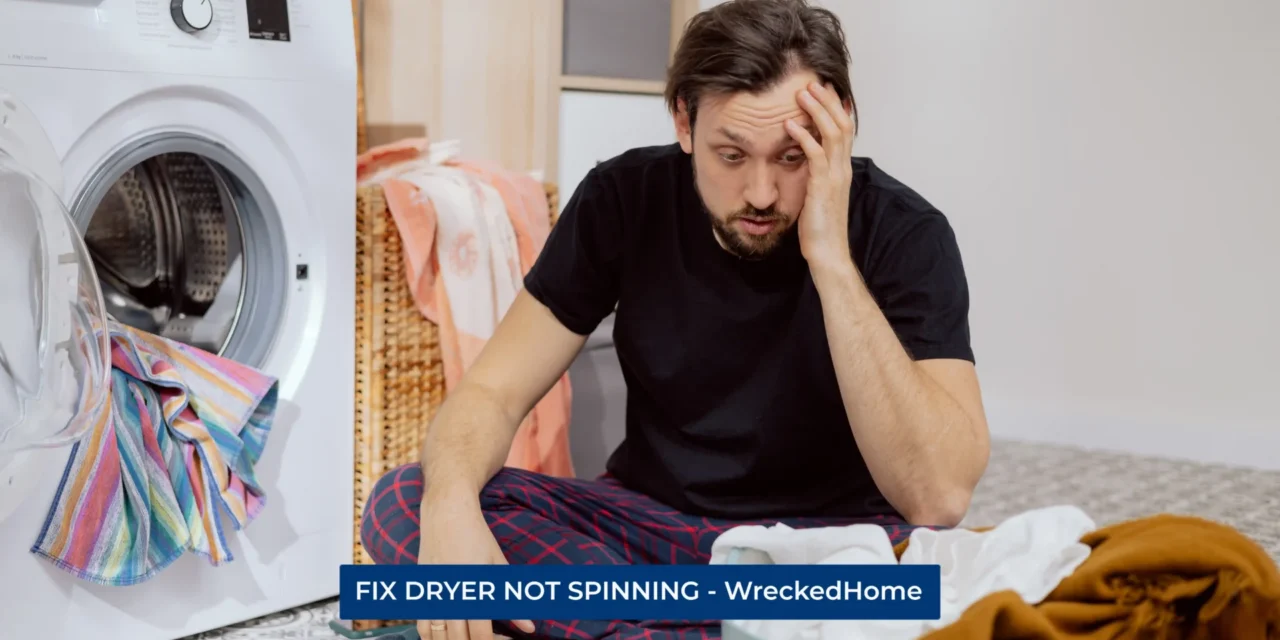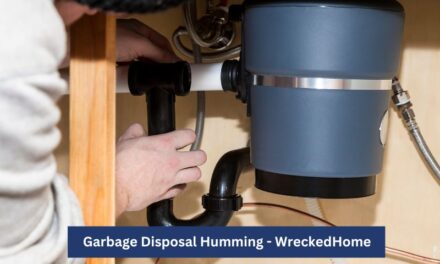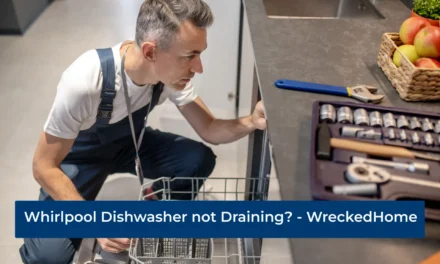Cleaning laundry is an important home chore. Every household values the convenient and efficient nature a dryer brings the laundry routine. Having a dryer not only speeds up the drying process, but it also ensures you have ready to wear clothes at all times.
But, like any appliance, a dryer can sometimes face issues that can lower the performance of your clothes drying. One such common hiccup that many homeowners encounter is the dryer not spinning. This hectic scenario can turn your laundry routine or day into a day of troubleshooting.
If you experienced it, you know the pain of your dryer turning on but not spinning. To solve this problem, we come with a guide that aims to demystify this often frustrating problem. By understanding the potential reasons behind the stationary drum, you can fix your issue with proper knowledge and confidence.
So next time your dryer refuses to spin, follow our actionable solutions to get it back in working order.
Reasons Why Your Dryer Not Spinning
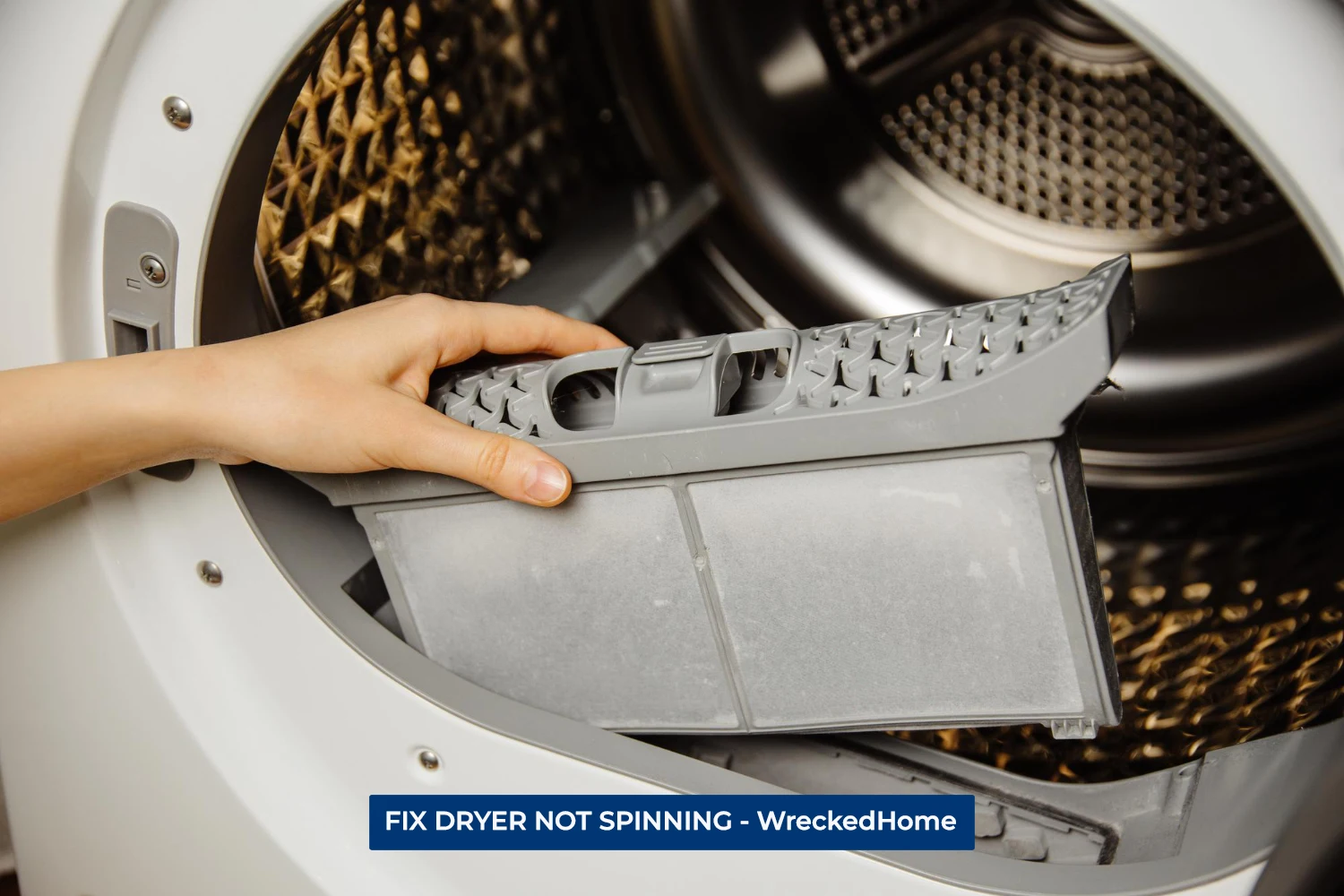
It is daunting task to fix a dryer if you are unaware of the reason behind your dryer not spinning. Therefore, its necessary to fix the common but vexing issue of your appliance refusing to spin. Just like every machine, the dryer also gives clear signs that something’s amiss. Before delving into repairs, understand the potential reasons behind your dryer’s spinning dilemma. Let’s look at the top reasons that can lead to your dryer’s improper functioning.
1. Broken Drive Belt
The drive belt is akin to the ‘connector’ that is a link source to bind the dryer’s motor with the drum. There is a thin loop of rubber that wraps around the drum and creates a tension pulley, and a motor pulley. The primary function of this belt is to turn the drum during the drying process. With the passage of time, the continuous use can cause wear and tear of this belt.
2. Worn Drum Rollers
Drum rollers act as support for the dryer drum that enables it to spin properly. The roller can be seen at the rear of the drum, which have the tendency to wear over time. If the problem is a worn roller then you will notice grinding noise or even feel resistance when manually turning the drum.
3. Worn Out Drum Bearing
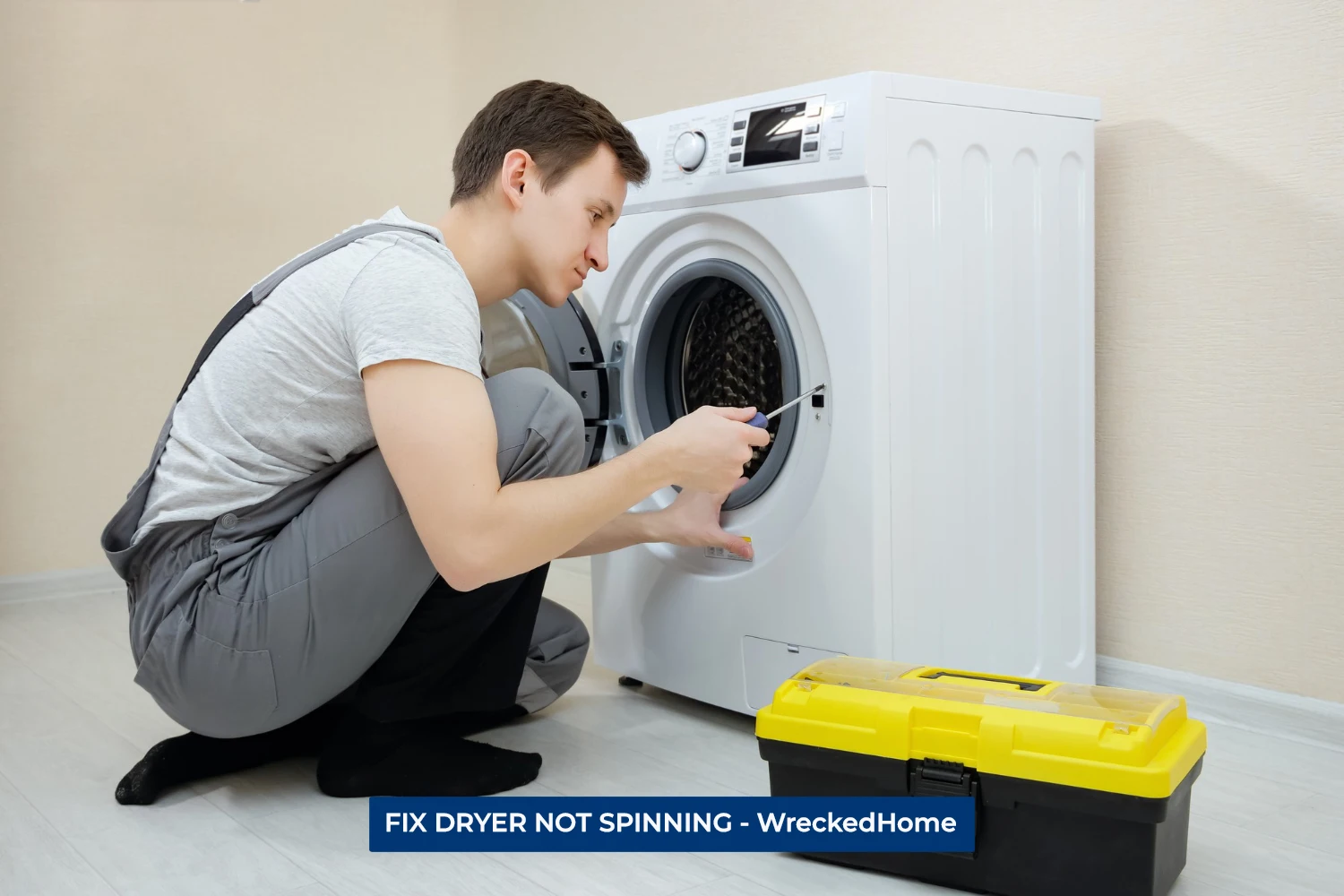
The drum bearing present at the back center of the drum provides support to the dryer. When you hear a high-pitched squealing sound then bearing is worn out. It hinders smooth rotation and causes difficulty in spinning or a noticeable decrease in performance.
4. Faulty Motor
The motor is the heartbeat of the dryer. This is the main element in driving the belt and, in turn, rotating the drum. Whenever you notice a hum or buzz in the drum moving then the issue is in the motor. You can also troubleshoot it with resetting the dryer, if the problem persists.
5. Defective Door Switch
The door switch is a safety feature that makes it sure to operate the dryer if the door is securely closed. However, the faulty door hinders spinning and leads it to stop functioning even if it powers on. A switch that doesn’t click when pressed or one that’s visibly damaged is a root cause of your dryer not spinning.
6. Broken Idler Pulley
The idler pulley plays a crucial role in maintaining tension and ensuring it doesn’t slip. However, this pulley can wear out or break with time and frequent use. It will also cause problems such as squealing noises in the dryer or an uneven rotation of the drum. If you notice these issues, check the idler pulley for wear or breakage.
7. Snapped Rear Bearing
This rear bearing is another component that provides essential support for the drum. When this component fails, it can prevent the drum from spinning. This will certainly lead to your dryer not spinning. An evident indication of a problem is the emergence of a loud rumbling noise when the start button is pressed.
8. Worn Out Drum Glides or Slides
Drum glides or slides help the front of the dryer drum glide. It is the reason for smooth movement of the front part of the dryer drum along the frame. As they deteriorate, the drum’s rotation becomes uneven and you might hear scraping sounds. Upon examination, you’ll notice scorched or frayed glides that hinder dryer performance.
9. Obstructed Lint Filter
An overlooked, yet essential component, is the lint filter. The lint filter captures lint from your clothes. So, improper care and neglected cleaning causes decreased airflow and efficiency. Prolonged drying times can be a clear indicator of obstruction lint in a lint filter. In severe instances, a heavily clogged lint filter can hinder the drum from spinning effectively.
Solutions: How to Fix a Dryer Not Spinning
Addressing the perplexing issue of a dryer can be an overwhelming situation that can handle with the right knowledge and a methodical approach. To restore your dryer if you encounter the problem of your dryer not spinning, follow these targeted solutions for each potential issue:
1. Replace the Drive Belt
As you know, the drive belt is central to the dryer’s rotation. Longtime use can cause the belt to be worn. Therefore, you need to access the interior of the dryer. To replace the belt, unplug the dryer and remove the rear or front panel. Now position the new belt and align it with the tension pulley and motor pulley. You must ensure it is securely fit before use.
2. Inspect Drum Rollers
The drum rollers that ensure a smooth tumble require proper inspection. If the rollers appear worn or don’t spin freely, then it needs to be replaced. When you are installing new rollers, you must ensure it is fixed and rotate without resistance.
3. Address the Drum Bearing
To assess the drum bearing, access the dryer’s interior, usually from the rear. If the bearing appears worn out or produces a squealing sound, it’s time for fixing or replacement. When installing a new bearing, make sure it’s appropriately lubricated (if necessary) and sits flush against the drum’s rear, offering unhindered rotation.
Visit our store for 10% off our Home Maintenance products here.
4. Troubleshoot the Motor
Diagnosing motor problems can be a challenge, especially when there is buzzing or humming noises. If you are suspicious about the motor then inspect for signs of wear, damage, or overheating. Conduct a visual inspection for the motor shaft. If you see restricted rotation or excessive heat, it might be time for a motor replacement. Don’t forget to double-check and secure all connections before trying to re start your dryer.
5. Test and Replace the Door Switch
Ensuring the door switch functions properly is important for dryer spinning. To assess it, open the dryer door and manually press the switch. If there is no click sound then it could be faulty. At this time, replacement of door switch is necessary.
6. Replace the Rear Bearing
When dealing with a worn or broken rear bearing that is responsible for your dryer not spinning check out it properly. If it is affecting the spinning function, then access the back of the dryer and locate the bearing. If it’s visibly damaged, then you need to replace it with new one.
7. Access the Lint Filter
A clean lint filter can run for years but if it’s clogged then the performance drops. Therefore, its necessary to clean it with a brush when the problem is your dryer not spinning. For proper cleaning, wash it with warm soapy water. But keep in mind to dry it completely before reinserting.
In all repair endeavors, remember to have appropriate knowledge, the right tools, and a safety-first mindset. Always remember to disconnect your dryer from its power source and follow the professional guidelines.
Conclusion
Dryers are essential household appliances that make your washing day routine hassle free. But over time there can be some issues that prolong your dryer not spinning. Regular maintenance and periodic checks are vital; for longevity and performance. Remember to power off the dryer from its power source before embarking on any repair. Use the right tools and techniques for excellent results if you have the problem of you dryer not spinning.
For any repairs, installations, builds, or questions; We recommend you to hire a professional. Find A Pro Near You Here!
FAQs
Can a dryer still dry without spinning?
While a dryer can technically still dry without spinning, the proper performance will not come as a result. The drum’s spinning action is crucial for even distribution of heated air to do efficient drying. Without it, clothes may dry unevenly, with some sections remaining damp that look awful and feel uncomfortable by wearing.
How long does a dryer belt last?
A dryer belt is built for durability but regular use can lower its life. If you are using it on a regular basis then it can with stand for 10 to 20 years. It’s a worthy investment to repair if you want to enjoy a hassle free drying experience. For optimal results and belt longevity, it’s advised to consult with a technician and follow manufacturer guidelines.
What voltage is a dryer motor?
The common voltage requirement for a dryer is 120 volts. Additionally, these dryers often have heating coils that run on a higher voltage of 240 volts, to perform a clean dry and wrinkle free experience. They also produce a heat output of approximately 5500 watts.
How does a dryer cycle work?
In electric dryers, the complete dryer cycle consists of 2 steps. In the first step, an electric heating element warms up, then metal coils use heat to dry the clothes. On the other hand, gas dryers utilize either natural gas or propane that produces the required heating. Regardless of the heat source, an integral ventilation system expels moist air that is a source of an efficient drying mechanism.
What are the 3 types of dryers?
On the basis of respective drying processes, there are 3 types of dryers: condenser, heat pump, and vented tumble dryers. Each type operates on distinctive mechanisms that not only offer unique advantages, but also cater to different drying needs and preferences.

